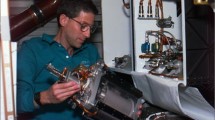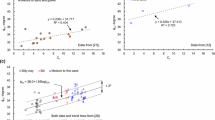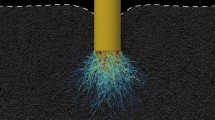Abstract
Traversing granular regolith, especially in reduced gravity environments, remains a potential challenge for wheeled rovers. Mitigating hazards for planetary exploration rovers requires testing in representative environments, but direct Earth-based testing fails to account for the effect of reduced gravity on the soil itself. Granular scaling laws (GSL) have been proposed in the literature to predict performance of a larger wheel based on tests with a smaller wheel, or to predict performance in one gravity level based on tests in another gravity level. However, this is the first work to experimentally validate GSL in reduced gravity. Here, an expanded version of existing GSL was evaluated experimentally by measuring performance of a single wheel driving through cohesionless lunar soil simulant GRC-1 aboard parabolic flights that reproduce the effects of lunar gravity, and comparing those results to scaled tests performed on the ground. This scaled-wheel testing achieved less than 10% prediction error on three measured output metrics: drawbar pull (i.e. net traction), sinkage, and power draw. Predictions also erred on the conservative side. Subsurface soil imaging revealed similar soil behavior between scaled tests. GSL thus offers an accurate and conservative method for predicting wheel performance in reduced gravity based on 1-g experiments, at least in cohesionless soil.










Similar content being viewed by others
Data Availability
All datasets generated and analyzed during the current study (except the video/image data, due to large file sizes), along with processing code, are available in a GitHub repository: https://github.com/adrianadaca/MGST-data-and-processing-code. Video datasets are available from the corresponding author on request.
Notes
True rate-independence would be achieved at \(\text {Fr}\le 10^{-3}\) (Henann and Kamrin 2016).
References
Bekker, M.G.: Theory of land locomotion. University of Michigan Press, Ann Arbor (1956)
Biguri, A.: Perceptually uniform colormaps (2019). https://www.mathworks.com/matlabcentral/fileexchange/51986-perceptually-uniform-colormaps
Brown, D., Webster, G.: Now a stationary research platform, NASA’s Mars rover Spirit starts a new chapter in red planet scientific studies. NASA Press Release (2010). https://www.nasa.gov/mission_pages/mer/news/mer20100126.html
Callas, J.L.: Mars exploration rover spirit end of mission report. Tech. Rep. JPL D-92756 (2015)
Carrier, W.D., Olhoeft, G.R., Mendell, W.: Physical properties of the lunar surface. Lunar Sourcebook pp 475–594 (1991)
Carsten, J., Rankin, A., Ferguson, D., et al.: Global planning on the Mars Exploration Rovers: Software integration and surface testing. J. Field Rob. 26(4), 337–357 (2009)
Costes, N.C., Farmer, J.E., George, E.B.: Mobility Performance of the Lunar Roving Vehicle: Terrestrial Studies, Apollo 15 Results, vol 401. NASA (1972)
Daca, A., Nassiraei, A.A.F., Tremblay, D., et al.: Comparison of wheel load application methods in single wheel testbeds. J. Terrramech. (In Press) (2021a)
Daca, A., Tremblay, D., Skonieczny, K.: The relationship between cone penetration resistance and wheel-soil interactions in lunar gravity. In: IEEE Aerospace Conference Proceedings (2021b)
Daca, A., Tremblay, D., Skonieczny, K.: Experimental evaluation of cone index gradient as a metric for the prediction of wheel performance in reduced gravity. J. Terrramech. 99, 1–16 (2022)
Edwards, M.B., Dewoolkar, M.M., Huston, D.R., et al.: Bevameter testing on simulant fillite for planetary rover mobility applications. J. Terrramech. 70, 13–26 (2017)
Fong, T.: Volatiles investigating polar exploration rover. In: Australasian Conference on Robotics and Automation (2020)
Freitag, D., Green, A., Melzer, K.: Performance evaluation of wheel for lunar vehicles. Marshall Space Flight Center National Aeronautics and Space Administration pp 1–53 (1970a)
Freitag, D.R., Schafer, R.L., Wismer, R.D.: Similitude studies of soil-machine systems. J. Terrramech. 7(2), 25–58 (1970b)
Freitag, D.R., et al.: A dimensional analysis of the performance of pneumatic tires on soft soils, vol 3. Auburn University (1965)
Fujiwara, A., Kawaguchi, J., Yeomans, D., et al.: The rubble-pile asteroid Itokawa as observed by Hayabusa. Science 312, 1330–1334 (2006)
Henann, D.L., Kamrin, K.: A finite element implementation of the nonlocal granular rheology. Int. J. Numer. Meth. Eng. 108(4), 273–302 (2016)
Heverly, M., Matthews, J., Lin, J., et al.: Traverse performance characterization for the Mars Science Laboratory rover. J. Field Rob. 30(6), 835–846 (2013)
Huang, L., Zhu, J., Yuan, Y., et al.: A dynamic resistive force model for designing mobile robot in granular media. IEEE Robot. Autom. Lett. 7(2), 5357–5364 (2022)
International Space Exploration Coordination Group.: Global exploration roadmap. Tech. rep, National Aeronautics and Space Administration Headquarters, Washington, DC (2018)
Jiang, M., Liu, F., Wang, H., et al.: Investigation of the effect of different gravity conditions on penetration mechanisms by the distinct element method. Eng. Comput. 32(7), 2067–2099 (2015)
Johnson, K., Asnani, V., Polack, J., et al.: Experimental evaluation of the scale model method to simulate lunar vehicle dynamics. In: International Society for Terrain-Vehicle Systems (ISTVS) Americas Regional Conference (2016)
Jop, P., Forterre, Y., Pouliquen, O.: A constitutive law for dense granular flows. Nature 441(7094), 727–730 (2006)
Kanamori, H.: Terramechanics in lunar and planetary exploration. Journal of the Robotics Society of Japan 21(5), 480–483 (2003). (In Japanese)
Kobayashi, T., Fujiwara, Y., Yamakawa, J., et al.: Mobility performance of a rigid wheel in low gravity environments. J. Terrramech. 47, 261–274 (2010). https://doi.org/10.1016/j.jterra.2009.12.001
Kovács, L.L., Ghotbi, B., González, F., et al.: Effect of gravity in wheel/terrain interaction models. J. Field Robot. 37(5), 754–767 (2020)
Kuroda, Y., Teshima, T., Sato, Y., et al.: Mobility performance evaluation of planetary rover with similarity model experiment. In: IEEE International Conference on Robotics and Automation, 2004. Proceedings. ICRA’04. 2004, IEEE, pp 2098–2103 (2004)
Kuroda, Y., Teshima, T., Sato, Y., et al.: Mobility performance evaluation of planetary rovers in consideration of different gravitational acceleration. In: 2005 IEEE/RSJ International Conference on Intelligent Robots and Systems, IEEE, pp 2991–2996 (2005)
Lessem, A.S.: Operations and maintenance manual for a scale-model lunar roving vehicle. Tech. rep., U.S. Army Engineer Waterways Experiment Station (1972)
Li, C., Zhang, T., Goldman, D.I.: A terradynamics of legged locomotion on granular media. Science 339(6126), 1408–1412 (2013)
Li, M., Gao, F., Sun, P.: Prediction method of lunar rover’s tractive performance based on similitude methodology. In: Fifth International Conference on Intelligent Computation Technology and Automation, IEEE, pp 686–689 (2012)
Markow, E.: Predicted behavior of lunar vehicles with metalastic wheels. SAE Trans. 72, 388–396 (1964)
Mullis, C.H.: A study and analysis of the MSFC lunar roving vehicle dust profile test program. Tech. Rep. NASA CR-121075, NASA (1971)
Murphy, N., Green, A.: Effects of test techniques on wheel performance. J. Terrramech. 6(1), 37–52 (1969). https://doi.org/10.1016/0022-4898(69)90069-X
Nassiraei, A.A.F., Skonieczny, K.: Grousers improve drawbar pull by reducing resistance and generating thrust at the front of a wheel. J. Terrramech. 91, 73–84 (2020). https://doi.org/10.1016/j.jterra.2020.05.005
Niksirat, P., Daca, A., Skonieczny, K.: The effects of reduced-gravity on planetary rover mobility. Int. J. Robot. Res. 39(7), 797–811 (2020). https://doi.org/10.1177/0278364920913945
Oravec, H., Zeng, X., Asnani, V.: Design and characterization of GRC-1: A soil for lunar terramechanics testing in earth-ambient conditions. J. Terrramech. 47(6), 361–377 (2010). https://doi.org/10.1016/j.jterra.2010.04.006
Rodríguez-Martínez, D., Van Winnendael, M., Yoshida, K.: High-speed mobility on planetary surfaces: A technical review. J. Field Rob. 36(8), 1436–1455 (2019)
Rozitis, B., MacLennan, E., Emery, J.P.: Cohesive forces prevent the rotational breakup of rubble-pile asteroid (29075) 1950 DA. Nature 512(7513), 174–176 (2014)
Schafer, R.L.: Model-prototype studies of tillage implements. PhD thesis (1965)
Schuring, D.: Scale model testing of land vehicles in a simulated low gravity field. SAE Trans. 75, 699–705 (1967)
Skonieczny, K., Moreland, S.J., Wettergreen, D.S.: A grouser spacing equation for determining appropriate geometry of planetary rover wheels. In: 2012 IEEE/RSJ International Conference on Intelligent Robots and Systems, IEEE, pp 5065–5070 (2012). https://doi.org/10.1109/IROS.2012.6386203
Skonieczny, K., Moreland, S., Inotsume, H., et al.: Visualizing and Analyzing Machine-soil Interactions using Computer Vision. J. Field Rob. 31, 753–769 (2014)
Skonieczny, K., Wettergreen, D.S., Whittaker, W.L.: Advantages of continuous excavation in lightweight planetary robotic operations. Int. J. Robot. Res. 35(9), 1121–1139 (2016)
Skonieczny, K., Niksirat, P., Nassiraei, A.: Rapid automated soil preparation for testing planetary rover-soil interactions aboard reduced-gravity aircraft. J. Terrramech. 83, 35–44 (2019a). https://doi.org/10.1016/j.jterra.2019.03.001
Skonieczny, K., Niksirat, P., Nassiraei, A.A.F.: Rapid automated soil preparation for testing planetary rover-soil interactions aboard reduced-gravity aircraft. J. Terrramech. 83, 35–44 (2019b)
Slonaker, J., Motley, D.C., Zhang, Q., et al.: General scaling relations for locomotion in granular media. Phys. Rev. E 95(5), 052901 (2017)
Soltynski, A.: Physical similarity and scale effects in soil-machine systems. J. Terrramech. 5(2), 31–43 (1968)
Sullivan, R.: Earthmoving in minature. J. Terrramech. 1(4), 85–106 (1964)
Sullivan, R., Anderson, R., Biesiadecki, J., et al.: Cohesions, friction angles, and other physical properties of martian regolith from mars exploration rover wheel trenches and wheel scuffs. J. Geophys. Res. Planets. 116(E2) (2011)
Tang, Z., Liu, J., Wang, X., et al.: Physical and mechanical characteristics of lunar soil at the chang’e-4 landing site. Geophys. Res. Lett. 47(22):e2020GL089,499 (2020)
Thoesen, A., McBryan, T., Marvi, H.: Helically-driven granular mobility and gravity-variant scaling relations. RSC Adv. 9(22), 12572–12579 (2019)
Thoesen, A., McBryan, T., Green, M., et al.: Revisiting scaling laws for robotic mobility in granular media. IEEE Robot. Autom. Lett. 5(2), 1319–1325 (2020a)
Thoesen, A., McBryan, T., Mick, D., et al.: Comparative performance of granular scaling laws for lightweight grouser wheels in sand and lunar simulant. Powder Technol. 373, 336–346 (2020b)
Thoesen, A., McBryan, T., Mick, D., et al.: Granular scaling laws for helically driven dynamics. Phys. Rev. E 102(3), 032902 (2020c)
Ulamec, S., Michel, P., Grott, M., et al.: A rover for the jaxa mmx mission to phobos. In: 70th InternationalAstronautical Congress, International Astronautical Federation, pp IAC–19 (2019)
Wismer, R., Freitag, D., Schafer, R.: Application of similitude to soil-machine systems. J. Terrramech. 13(3), 153–182 (1976)
Zhang, Q., Townsend, S., Kamrin, K.: Expanded scaling relations for locomotion in sloped or cohesive granular beds. Phys. Rev. Fluids 5(11), 114301 (2020)
Acknowledgements
This project was undertaken with the financial support of the Canadian Space Agency, the Natural Sciences and Engineering Research Council of Canada (NSERC), and the Fonds de Recherche du Québec - Nature et Technologies (FRQNT). The authors thank Canada’s National Research Council Flight Research Laboratory, especially Derek ‘‘Duff’’ Gowanlock and Shahrukh Alavi, for facilitating the parabolic flight campaign. The authors would also like to thank Pierre-Lucas Aubin-Fournier for 3D printing the rigid wheels.
Funding
The authors disclose receipt of the following financial support for the research, authorship, and publication of this article: This work was supported by the Canadian Space Agency [grant number 19FACONB28] and the Natural Sciences and Engineering Research Council of Canada [grant numbers 950-230594, 950-232803, RGPIN-2015-2015-06046].
Author information
Authors and Affiliations
Contributions
K.S. and A.D. conceived of the presented idea. A.D. performed the experiments, analyzed the results, and wrote the manuscript. D.T. modified the experimental apparatus, assisted with setting up the experiments, and supported the analysis. K.S. encouraged A.D. to investigate this topic and supervised the findings of this work. All authors discussed the results and contributed to the final manuscript.
Corresponding author
Ethics declarations
Ethics Approval
Not applicable.
Consent to Participate
Not applicable.
Consent for Publication
Not applicable.
Conflicts of Interest
The authors declare no competing interests as defined by Springer, or other interests that might be perceived to influence the results and/or discussion reported in this paper.
Additional information
Publisher's Note
Springer Nature remains neutral with regard to jurisdictional claims in published maps and institutional affiliations.
Rights and permissions
Springer Nature or its licensor (e.g. a society or other partner) holds exclusive rights to this article under a publishing agreement with the author(s) or other rightsholder(s); author self-archiving of the accepted manuscript version of this article is solely governed by the terms of such publishing agreement and applicable law.
About this article
Cite this article
Daca, A., Tremblay, D. & Skonieczny, K. Expansion and Experimental Evaluation of Scaling Relations for the Prediction of Wheel Performance in Reduced Gravity. Microgravity Sci. Technol. 35, 59 (2023). https://doi.org/10.1007/s12217-023-10087-4
Received:
Accepted:
Published:
DOI: https://doi.org/10.1007/s12217-023-10087-4




